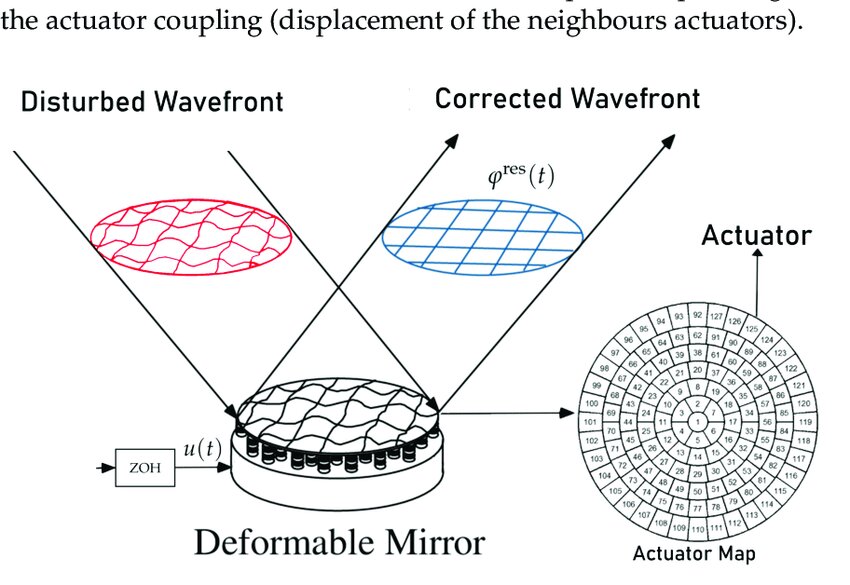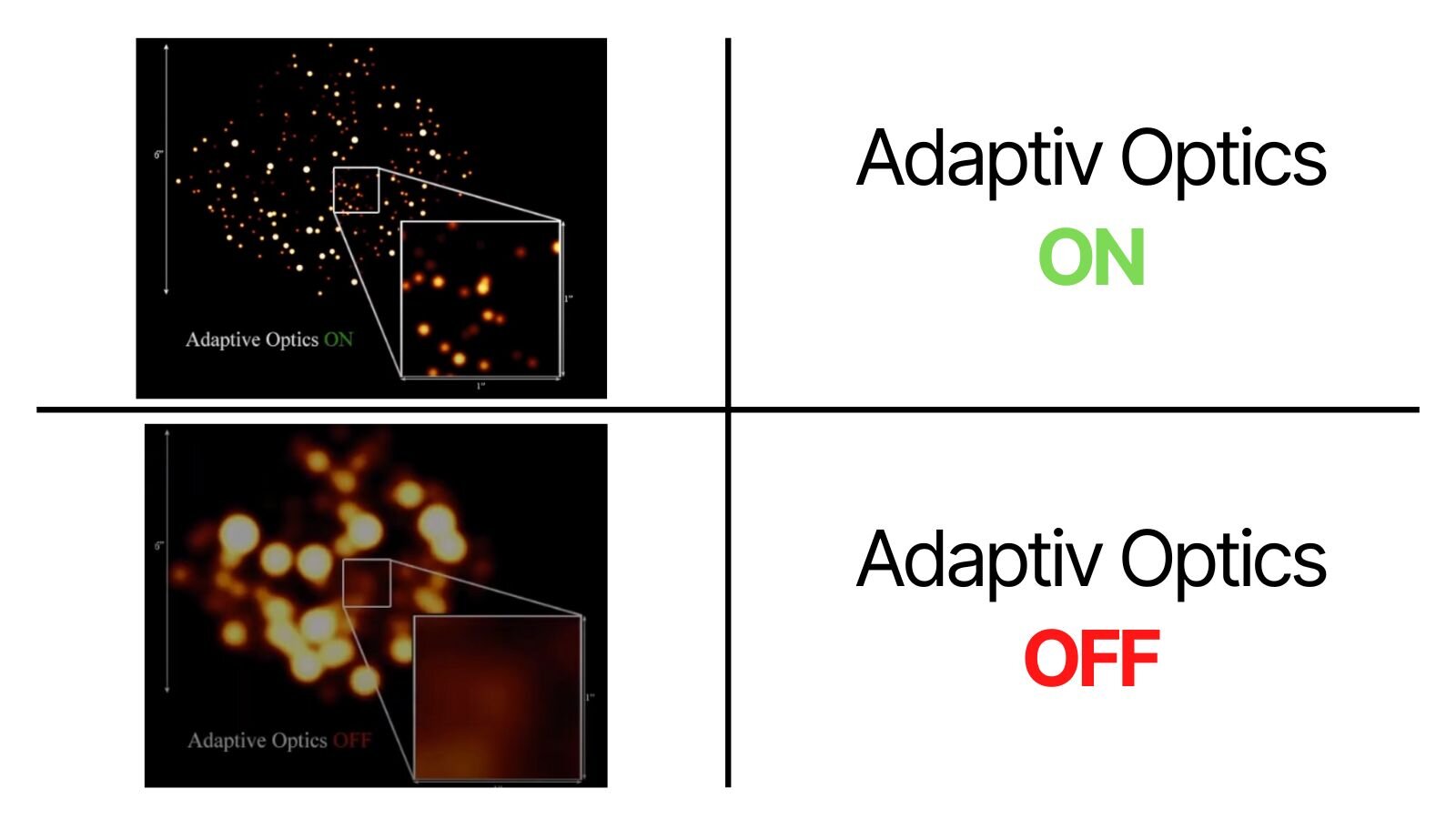Adaptive optics is a technique used in astronomy to reduce the effects of atmospheric turbulence to make astronomical observations clearer.
The idea is based on the principle that some light from objects in space is scattered by air molecules and particles.
This has two effects: it reduces the amount of light arriving at a telescope and can distort or magnify images.
Adaptive optics tries to compensate for these problems by using computer-controlled mirrors to introduce an artificial correction.
This article presents the challenges in observing the sky with a ground telescope and demonstrates the need and use of adaptive optics.
Contents
Astronomers + Engineers = Adaptive Optics System
When thinking about astronomers, people imagine an old guy with white hair and a beard wearing a lab coat looking through the lenses of a telescope and trying to find a phenomenon in the sky.
But nowadays, an astronomer is someone working behind a computer, analyzing data (numbers or images).

These data are obtained through digital cameras installed on instruments designed specifically for their research.
To build these instruments, astronomers work with engineers who will consider what the astronomers want to observe. Then they will design the mechanism and provide data to the astronomer.
The observation goals can vary significantly because different areas of astronomy exist :
Observational astronomy
- Radio astronomy
- Infrared astronomy
- Optical astronomy
- Ultraviolet astronomy
- X-ray astronomy
- Gamma-ray astronomy
- Fields not based on the electromagnetic spectrum
- Astrometry and celestial mechanics
Theoretical astronomy
- Astrophysics
- Astrochemistry
- Astrobiology
- Physical cosmology
- Extragalactic astronomy
- Galactic astronomy
- Stellar astronomy
- Solar astronomy
- Planetary science
In this article, we will focus on optical astronomy. A technique that provides astronomers with images through the mirrors of a telescope.
Why Do We Need Adaptive Optics?
Telescopes have been around since the 17th century. Still, technological advances allow an engineer to design more giant and more accurate telescopes that collect more and more light to observe objects that are not visible to the unaided eye or a smaller telescope.

As you may have understood, the farther away the object observed is, the dimmer the light is. And these are the objects that astronomers want to get to know better.
They need a giant telescope to collect more light and improve image quality.
A problem arose from these bigger telescopes. The image quality didn’t get better, and the culprit was the atmosphere.
The Atmosphere is a Huge Nuisance for Astronomers
The atmosphere constantly changes, making it difficult for telescopes to focus on distant objects.
The adaptive optics system compensates for this by using a deformable mirror or a liquid crystal device (LCD) panel that changes shape thousands of times per second in order to correct the distortion caused by atmospheric turbulence.
To illustrate the effect of the atmosphere on the images observed through a telescope, let’s set up a simple example :
It’s summertime, the weather is hot, and your family is gathered outside. You’re sipping a cold lemonade while daddy takes care of the barbecue.
Behind the barbecue, all the sauce bottles are lined up, and you’re trying to read the label of those bottles through the barbecue heat. Everything is blurry and wavy due to the warmth generated by the fire.
The temperature difference is the cause of the blur.
The same phenomena of temperature differences lead to deformed images in telescopes.
But a solution has been developed to correct these images and render them as if the atmosphere was not there: adaptive optics.
The Adaptive Optics 101- How it Works?

Sensing the deformation: wave-front sensor
First, we need to know how the light comes to the sensor and, most importantly, how deformed it arrives in the system. A device called the wave-front sensor is used for that purpose.
The wave-front sensor was invented by Dr. James R. Wilson, who received a Nobel Prize in Physics in 1978.

Correcting the deformation: Deformable mirror
Then after computation in the system, a deformable mirror changes its shape to reform the light as it should have been without the atmosphere.
Deformable mirrors are made up of many tiny segments. These segments can be adjusted individually to produce a smooth, clear image.
And finally, the image that the scientist expect is ready to be analyzed.

A simple adaptive optics system
Here is a video describing a simple adaptive optics system. The light comes from a star near the object we want to study. It reaches the telescope, and the adaptive optics system measures the deformation of the light and corrects it before it comes to the science camera that records the data for the astronomer.
What are the Disadvantages of Using an Adaptive Optics System?
Adaptive optics systems are not perfect…..jet. The primary disadvantage of adaptive optics is that they require a very large and expensive telescope.
What kind of telescope uses adaptive optics?
Adaptive optics are used in positioning big reflecting telescopes, like the ones optimized for modern astronomy. You may recognize these as the large “primary mirror” and smaller “secondary mirror” that often make up a telescope’s design.
List of the biggest telescopes that use adaptive optics
- Large Synoptic Survey Telescope (LSST)
- South African Large Telescope (SALT)
- Keck I and II Telescopes
- Gran Telescopio Canarias (GTC)
- Giant Magellan Telescope (GMT)
- Thirty Meter Telescope (TMT)
- European Extremely Large Telescope (E-ELT)
Conclusion and Next Steps for Further Learning on this Topic
The conclusion of this article is that adaptive optics are a necessity for high-quality astronomy. Adaptive optics systems are the best way to compensate for atmospheric turbulence, which will allow us to take clearer images of the Universe.
Next steps for further learning on this topic:
If you want to learn more about adaptive optics and adaptive optics systems, check the links in this article.


